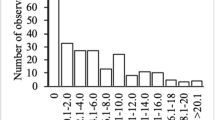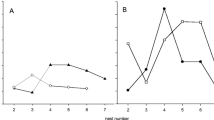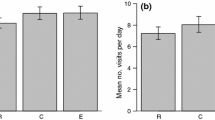Abstract
We tested several predictions of nest defense theory by observing variation in flushing distance and probability of nest abandonment within and between six species of waterfowl. In these species, only the females incubate eggs and attend offspring. First, we examined whether flushing distance by females varied in relation to clutch size, stage of incubation, and time of season, after controlling for the number of visits made to nests by observers. Revisits by observers appeared to affect flushing distance by females for reasons unrelated to the relative value of the current clutch. We found that as incubation progressed, females allowed observers to approach more closely before flushing from the nest. In some species, females with larger clutches allowed closer approaches to nests before flushing which was also consistent with nest defense theory. In contrast, time of season (Julian date) did not relate to flushing distance for any species. When species were compared, we found that species with moderate to high yearly mortality and high reproductive output per breeding attempt (e.g., northern shoveler and blue-winged teal) were less likely to abandon nesting attempts and exhibited “riskier” behavior (remained at nests when approached closely by observers) than species that had lower yearly mortality (e.g., mallard). Our results show that flushing distance and patterns of nest abandonment by female ducks conform to several predictions of nest defense theory.
Similar content being viewed by others
References
Andersson M, Wiklund CG, Rundgren H (1980) Parental defence of offspring: a model and an example. Anim Behav 28: 536–542
Armstrong T, Robertson RR (1988) Parental investment based on clutch value: nest desertion in response to partial clutch loss in dabbling ducks. Anim Behav 36:941–943
Arnold TW, Rohwer FC, Armstrong T (1987) Egg viability, nest predation, and the adaptive significance of clutch size in prairie ducks. Am Nat 130:643–653
Barash DP (1975) Evolutionary aspects of parental behavior of the Alpine Accentor. Wilson Bull 87:367–373
Bellrose FC (1980) Ducks, geese, and swans of North America. Stackpole Books, Harrisburg, PA
Blancher PJ, Robertson RJ (1982) Kingbird aggression: does it deter predation? Anim Behav 30:929–930
Brunton DH (1986) Fatal antipredator behavior of a killdeer. Wilson Bull 98:605–607
Brunton DH (1990) The effects of nesting stage, sex, and type of predator on parental defense by killdeer (Charadrius vociferous): testing models of avian parental defense. Behav Ecol Sociobiol 26:181–190
Clark RG, Sugden LG, Kent Brace R, Nieman DJ (1988) The relationship between nesting chronology and vulnerability to hunting of dabbling ducks. Wildfowl 89:137–144
Cooke F, Findlay CS, Rockwell RF (1984) Recruitment and timing of reproduction in lesser snow geese (Chen caerulescens caerulescens) Auk 101:451–458
Curio E, Regelmann K (1985) The behavior dynamics of great tit (Parus major) approaching a predator. Z Tierpsychol 69:3–18
Curio E, Regelmann K (1987) Do great tit (Parus major) parents gear their brood defense to the quality of their young? Ibis 129:344–352
Curio E, Regelmann K, Zimmermann U(1984) The defense of first and second broods by great tit (Parus major) parents: a test of predictive socibiology. Z Tierpsychol 66:100–127
Forbes MRL, Barkhouse HP, Smith PC (1989) Nest-site selection by pied-billed grebes, Podilymbus podiceps. Ornis Scand 20:211–218
Gloutney ML, Clark RG, Afton AD, Huff GJ (1993) Timing of nest searches for upland-nesting waterfowl. J Wildl Manage 57: 597–601
Greenwood RJ, Arnold PM, McGuire BG(1990) Protecting duck nests from mammalian predators with fences, traps, and a toxicant. Wildl Soc Bull 18:75–82
Greig-Smith PW (1980) Parental investment in nest defense by stonechats (Saxicola torquata). Anim Behav 28:604–619
Johnson DH, Sargeant AB (1971) Impact of red fox predation on the sex ratio of prairie mallards. USDI Fish Wild Serv, Wild Res Rep 6
Klett AT, Shaffer TL, Johnson DH (1988) Duck nest success in the prairie pothole region. J Wildl Manage 52:431–440
Knight RL, Temple SA (1986a) Why does intensity of avian nest defence increase during the nesting cycle? Auk 103:318–327
Knight RL, Temple SA (1986b) Methodological problems in studies of avian nest defence. Anim Behav 34:561–566
Knight RL, Temple SA (1986c) Nest defence in the American goldfinch. Anim Behav 34:887–897
Knight RL, Grout OJ, Temple SA(1987) Nest defence of the American crow in urban and rural areas. Condor 89:175–177
Krapu GL, Doty HA (1979). Age-related aspects of mallard reproduction. Wildfowl 30:35–59
Krementz DG, Sauer JR, Nichols JD (1989) Model-based estimates of annual survival rates are preferable to observed maximum lifespan statistics for use in comparative life history studies. Oikos 56:203–208
Mallory ML, Weatherhead PJ (1993) Observer effects on common goldeneye nest defence. Condor 95:467–469
Montgomerie RD, Weatherhead PJ (1988) Risks and rewards of nest defense by parent birds. Q Rev Biol 63:167–187
Orthmeyer DL, Ball IJ (1990) Survival of mallard broods on Benton Lake National Wildlife Refuge in northcentral Montana. J Wildl Manage 54:62–66
Pugesek BH (1983) The relationship between parental age and reproductive effort in the California gull (Larus californicus). Behav EcolSociobiol 13:161–171
Redondo T, Carranza J (1989) Offspring reproductive value and nest defense in the magpie (Pica pica). Behav Ecol Sociobiol 25:369–378
Regelmann K, Curio E (1983) Determinants in brood defence in the great tit (Parus major L). Behav Ecol Sociobiol 13:131–145
Regelmann K, Curio E (1986) How do great tit (Parus major) pair mates cooperate in brood defence? Behaviour 97:10–36
Ricklefs RE (1977) Reactions of some Panamanian birds to human intrusions at the nest. Condor 9:376–379
Roff DA (1992) The evolution of life histories: theory and analysis. Chapman and Hall, New York
Rohwer FC (1988) Inter- and intraspecific relationships between egg size and clutch size in waterfowl. Auk 105:161–176
Rotella JJ, Ratti JT (1992) Mallard brood survival and wetland habitat conditions in southwestern Manitoba. J Wildl Manage 56:499–507
Sargeant AB, Allen SH, Eberhardt RT (1984) Red fox predation on breeding ducks in midcontinent North America. Wildl Monogr 89
Siegel S, Castellan NJ Jr (1988) Nonparametric statistics for the behavioral sciences. McGraw-Hill, Toronto
Trivers RL (1972) Parental investment and sexual selection. In: Campbell B (ed) Sexual selection and the descent of man. Heinemann, London pp 136–179
Weatherhead PJ (1982) Risk-taking by red-winged blackbirds and the Concorde fallacy. Z Tierpsychol 60:199–208
Weatherhead PJ (1989) Nest defence by song sparrows: methodological and life history considerations. Behav Ecol Sociobiol 25:129–136
Weatherhead PJ (1990) Nest defence as shareable paternal care in. red-winged blackbirds. Anim Behav 39:1173–1178
Welty JC, Baptista L (1988) The life of birds. Saunders College Publishing, New York
Westneat DF (1989) Intensity of nest defense in indigo buntings increases with stage and not number of visits. Auk 106:747–749
Wiklund CG (1990). Offspring protection by merlin Falco columarius: the importance of brood size and expected offspring survival for defense of young. Behav Ecol Sociobiol 26: 217–223
Wilkinson L (1989) Systat: the system of statistics. Systat Inc Evanston IL
Zar JH (1984) Biostatistical analyses. Prentice-Hall, Englewood Cliffs, NJ
Author information
Authors and Affiliations
Additional information
Correspondence to: M.R.L. Forbes
Rights and permissions
About this article
Cite this article
Forbes, M.R.L., Clark, R.G., Weatherhead, P.J. et al. Risk-taking by female ducks: intra- and interspecific tests of nest defense theory. Behav Ecol Sociobiol 34, 79–85 (1994). https://doi.org/10.1007/BF00164178
Received:
Accepted:
Issue Date:
DOI: https://doi.org/10.1007/BF00164178




